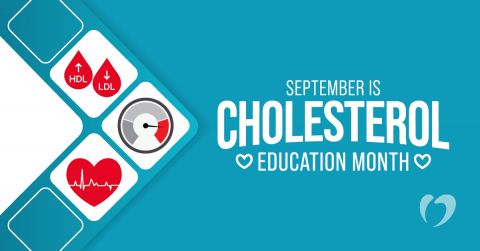Cholesterol and Heart Health

Most people have a general understanding that too much cholesterol is bad for the heart. However, not as many people understand the full picture of cholesterol and heart health, including the difference between good and bad cholesterol and what healthy cholesterol levels look like. September is National Cholesterol Education Month, which is a great opportunity to learn a little more about cholesterol and how it affects the heart.
What is cholesterol?
Cholesterol is a waxy substance your body makes that is an essential building block for cell membranes, vitamins, and hormones. Your body produces all the cholesterol it needs to perform these functions, but diet contributes to cholesterol levels as well. Dietary cholesterol is found in the animal products we eat, like butter, eggs, and meat.
Cholesterol by itself is not necessarily bad. In fact, the body needs it. Too often, however, an overabundance of cholesterol creates risk for heart disease and clogged arteries.
There are two types of cholesterol, LDL and HDL. LDL is known as bad cholesterol — the type that can form plaque and clog arteries. HDL is generally known as good cholesterol and can carry LDL out of the body. In measuring a healthy range for cholesterol, there are three numbers to consider: the amount of LDL and HDL and the two combined to show total cholesterol. Cholesterol is measured in milligrams per deciliter, or mg/dL.
The following numbers are generally considered within the health range for cholesterol:
- LDL under 100 mg/dL
- HDL over 40 mg/dL
- Total cholesterol under 200 mg/dL
Checking your cholesterol
High cholesterol does not have any symptoms, so those with high cholesterol often have no idea until they have their levels checked. Typically, doctors will order a cholesterol check as a part of a routine blood draw, though most healthy adults may only get this number checked every few years. After age 40, doctors begin to consider risk levels to determine how often a panel should be done. Those with cardiovascular disease or other elevated risks will have cholesterol checked more often.
Blood work that includes cholesterol levels may require fasting before the blood draw. Your doctor will advise you of any dietary restrictions when they order the blood work. After the blood is drawn, a lab will analyze it, and results will come back in a few days.
If you have your cholesterol checked in conjunction with a public health screening or anywhere other than your doctor’s office, share your results with your primary care physician. Your physician will have a greater understanding of your personal risk factors and a better picture of your overall cardiovascular health.
Cholesterol and heart health
High cholesterol can increase the risk for heart disease. LDL cholesterol can form plaque in the arteries, which restricts blood flow and creates hardened, narrowed arteries. This puts the patient at risk for angina, coronary artery disease, heart attack, and stroke. When plaque prevents blood from moving efficiently, blood clots can form and eventually block the flow of blood to the brain, which can cause a stroke, or to the heart, which can result in a heart attack.
If you have a family history of high cholesterol or are at increased risk for heart disease, schedule an appointment with our physicians at OHH. They can help you understand your risk and your cholesterol levels.




